Identifying the Peak Flowering Dates of Winter Rapeseed with a NBYVI Index Using Sentinel-1/2
Abstract
1. Introduction
2. Materials and Methods
2.1. Study Areas
2.2. Data
2.2.1. Satellite Data
2.2.2. Auxiliary Data
2.2.3. Crop Sample Points
2.3. Methodology
2.3.1. Method for Obtaining Winter Rapeseed Distribution
2.3.2. NBYVI Index Development
2.3.3. Peak Flowering Date Identification
2.3.4. Accuracy Evaluation
2.3.5. Variation Trend of Peak Flowering Dates
3. Results
3.1. Winter Rapeseed Distribution
3.2. Spectral Features During the Flowering Period
3.3. SAR Features During the Flowering Period
3.4. NBYVI Index Features During the Flowering Period
3.5. Peak Flowering Dates Monitoring Accuracy
3.6. Peak Flowering Dates
3.6.1. Peak Flowering Dates and Temperature
3.6.2. Peak Flowering Dates and Elevation
3.6.3. Peak Flowering Dates and Latitude
4. Discussion
4.1. Phenological Characteristics of Crop Morphological Indices
4.2. NBYVI Index for Identifying Peak Flowering Dates
4.3. Temperature Fitting Using Elevation
4.4. Limitations and Perspectives
5. Conclusions
Author Contributions
Funding
Data Availability Statement
Conflicts of Interest
References
- Fu, D.-H.; Jiang, L.-Y.; Mason, A.S.; Xiao, M.-L.; Zhu, L.-R.; Li, L.-Z.; Zhou, Q.-H.; Shen, C.-J.; Huang, C.-H. Research progress and strategies for multifunctional rapeseed: A case study of China. J. Integr. Agric. 2016, 15, 1673–1684. [Google Scholar] [CrossRef]
- Rutkowski, A. The feed value of rapeseed meal. J. Am. Oil Chem. Soc. 1971, 48, 863–868. [Google Scholar] [CrossRef]
- Bell, J. Nutrients and toxicants in rapeseed meal: A review. J. Anim. Sci. 1984, 58, 996–1010. [Google Scholar] [CrossRef] [PubMed]
- Zhang, R.; Cao, J.-J.; Pu, C.; Li, Y.; Jin, H.-G. Analysis on production, import, export, supply and demand of rapeseed and rapeseed oil in China. China Oils Fats 2022, 47, 8–14, 52. [Google Scholar]
- Iglesias, F.M.; Miralles, D.J. Changes in Seed Weight in Response to Different Sources: Sink Ratio in Oilseed Rape; IJARIT Research Foundation: Srimangal, Bangladesh, 2014. [Google Scholar]
- Zhang, H.; Flottmann, S. Source-sink manipulations indicate seed yield in canola is limited by source availability. Eur. J. Agron. 2018, 96, 70–76. [Google Scholar] [CrossRef]
- Kirkegaard, J.A.; Lilley, J.M.; Brill, R.D.; Ware, A.H.; Walela, C.K. The critical period for yield and quality determination in canola (Brassica napus L.). Field Crops Res. 2018, 222, 180–188. [Google Scholar] [CrossRef]
- Rivelli, G.M.; Calderini, D.F.; Abeledo, L.G.; Miralles, D.J.; Rondanini, D.P. Yield and quality traits of wheat and rapeseed in response to source-sink ratio and heat stress in post-flowering. Eur. J. Agron. 2024, 152, 127028. [Google Scholar] [CrossRef]
- Del Río, L.; Bradley, C.; Henson, R.; Endres, G.; Hanson, B.; McKay, K.; Halvorson, M.; Porter, P.; Le Gare, D.; Lamey, H. Impact of Sclerotinia stem rot on yield of canola. Plant Dis. 2007, 91, 191–194. [Google Scholar] [CrossRef] [PubMed]
- Hacault, K.; Faust, R.; Butzen, S.; Jeschke, M. (Eds.) Agronomy Sciences Research Summary 2012; Pioneer: Tokyo, Japan, 2012; p. 40. [Google Scholar]
- Mercier, A.; Betbeder, J.; Baudry, J.; Le Roux, V.; Spicher, F.; Lacoux, J.; Roger, D.; Hubert-Moy, L. Evaluation of Sentinel-1 & 2 time series for predicting wheat and rapeseed phenological stages. ISPRS J. Photogramm. Remote Sens. 2020, 163, 231–256. [Google Scholar]
- d’Andrimont, R.; Taymans, M.; Lemoine, G.; Ceglar, A.; Yordanov, M.; van der Velde, M. Detecting flowering phenology in oil seed rape parcels with Sentinel-1 and-2 time series. Remote Sens. Environ. 2020, 239, 111660. [Google Scholar] [CrossRef]
- Bargiel, D. A new method for crop classification combining time series of radar images and crop phenology information. Remote Sens. Environ. 2017, 198, 369–383. [Google Scholar] [CrossRef]
- Domínguez, J.A.; Kumhálová, J.; Novák, P. Winter oilseed rape and winter wheat growth prediction using remote sensing methods. Plant Soil Environ. 2015, 61, 410–416. [Google Scholar] [CrossRef]
- Leach, J.; Milford, G.; Mullen, L.; Scott, T.; Stevenson, H. Accumulation of dry matter in oilseed rape crops in relation to the reflection and absorption of solar radiation by different canopy structures. Asp. Appl. Biol. 1989, 23, 117–123. [Google Scholar]
- Shen, M.; Chen, J.; Zhu, X.; Tang, Y. Yellow flowers can decrease NDVI and EVI values: Evidence from a field experiment in an alpine meadow. Can. J. Remote Sens. 2009, 35, 99–106. [Google Scholar] [CrossRef]
- Shen, M.; Chen, J.; Zhu, X.; Tang, Y.; Chen, X. Do flowers affect biomass estimate accuracy from NDVI and EVI? Int. J. Remote Sens. 2010, 31, 2139–2149. [Google Scholar] [CrossRef]
- Piekarczyk, J.; Sulewska, H.; Szymańska, G. Winter oilseed-rape yield estimates from hyperspectral radiometer measurements. Quaest. Geogr. 2011, 30, 77–84. [Google Scholar] [CrossRef]
- Sulik, J.J.; Long, D.S. Spectral indices for yellow canola flowers. Int. J. Remote Sens. 2015, 36, 2751–2765. [Google Scholar] [CrossRef]
- Sulik, J.J.; Long, D.S. Spectral considerations for modeling yield of canola. Remote Sens. Environ. 2016, 184, 161–174. [Google Scholar] [CrossRef]
- Pacheco, A.; McNairn, H.; Li, Y.; Lampropoulos, G.; Powers, J. Using RADARSAT-2 and TerraSAR-X satellite data for the identification of canola crop phenology. In Proceedings of the Remote Sensing for Agriculture, Ecosystems, and Hydrology XVIII, Edinburgh, UK, 26–28 September 2016; p. 999802. [Google Scholar]
- Wang, S.; Zhao, L.; Sun, W.; Wang, Y.; Zhao, X.; Bai, Y. Flowering Detection of Canola Using Dynamic Time Warping and Sentinel-1 Time Series Images. In Proceedings of the IGARSS 2023—2023 IEEE International Geoscience and Remote Sensing Symposium, Pasadena, CA, USA, 16–21 July 2023; pp. 3482–3485. [Google Scholar]
- Veloso, A.; Mermoz, S.; Bouvet, A.; Le Toan, T.; Planells, M.; Dejoux, J.-F.; Ceschia, E. Understanding the temporal behavior of crops using Sentinel-1 and Sentinel-2-like data for agricultural applications. Remote Sens. Environ. 2017, 199, 415–426. [Google Scholar] [CrossRef]
- Preidl, S.; Lange, M.; Doktor, D. Introducing APiC for regionalised land cover mapping on the national scale using Sentinel-2A imagery. Remote Sens. Environ. 2020, 240, 111673. [Google Scholar] [CrossRef]
- Lopez-Sanchez, J.M.; Cloude, S.R.; Ballester-Berman, J.D. Rice phenology monitoring by means of SAR polarimetry at X-band. IEEE Trans. Geosci. Remote Sens. 2011, 50, 2695–2709. [Google Scholar] [CrossRef]
- Lopez-Sanchez, J.M.; Vicente-Guijalba, F.; Ballester-Berman, J.D.; Cloude, S.R. Polarimetric response of rice fields at C-band: Analysis and phenology retrieval. IEEE Trans. Geosci. Remote Sens. 2013, 52, 2977–2993. [Google Scholar] [CrossRef]
- Yang, H.; Li, Z.; Chen, E.; Zhao, C.; Yang, G.; Casa, R.; Pignatti, S.; Feng, Q. Temporal polarimetric behavior of oilseed rape (Brassica napus L.) at C-band for early season sowing date monitoring. Remote Sens. 2014, 6, 10375–10394. [Google Scholar] [CrossRef]
- Fieuzal, R.; Baup, F.; Marais-Sicre, C. Monitoring wheat and rapeseed by using synchronous optical and radar satellite data—From temporal signatures to crop parameters estimation. Adv. Remote Sens. 2013, 2, 162–180. [Google Scholar] [CrossRef]
- McNairn, H.; Jiao, X.; Pacheco, A.; Sinha, A.; Tan, W.; Li, Y. Estimating canola phenology using synthetic aperture radar. Remote Sens. Environ. 2018, 219, 196–205. [Google Scholar] [CrossRef]
- Tian, H.; Meng, M.; Wu, M.; Niu, Z. Mapping spring canola and spring wheat using Radarsat-2 and Landsat-8 images with Google Earth Engine. Curr. Sci. 2019, 116, 291–298. [Google Scholar] [CrossRef]
- Liu, C.; Shang, J.; Vachon, P.W.; McNairn, H. Multiyear crop monitoring using polarimetric RADARSAT-2 data. IEEE Trans. Geosci. Remote Sens. 2012, 51, 2227–2240. [Google Scholar] [CrossRef]
- Han, J.; Zhang, Z.; Cao, J. Developing a new method to identify flowering dynamics of rapeseed using landsat 8 and sentinel-1/2. Remote Sens. 2020, 13, 105. [Google Scholar] [CrossRef]
- Braun, A. Retrieval of digital elevation models from Sentinel-1 radar data–open applications, techniques, and limitations. Open Geosci. 2021, 13, 532–569. [Google Scholar] [CrossRef]
- Fernandez-Beltran, R.; Haut, J.M.; Paoletti, M.E.; Plaza, J.; Plaza, A.; Pla, F. Multimodal probabilistic latent semantic analysis for sentinel-1 and sentinel-2 image fusion. IEEE Geosci. Remote Sens. Lett. 2018, 15, 1347–1351. [Google Scholar] [CrossRef]
- He, W.; Yokoya, N. Multi-temporal sentinel-1 and-2 data fusion for optical image simulation. ISPRS Int. J. Geo-Inf. 2018, 7, 389. [Google Scholar] [CrossRef]
- Chen, Y.; Bruzzone, L. Self-supervised SAR-optical data fusion of Sentinel-1/-2 images. IEEE Trans. Geosci. Remote Sens. 2021, 60, 1–11. [Google Scholar] [CrossRef]
- Steinhausen, M.J.; Wagner, P.D.; Narasimhan, B.; Waske, B. Combining Sentinel-1 and Sentinel-2 data for improved land use and land cover mapping of monsoon regions. Int. J. Appl. Earth Obs. Geoinf. 2018, 73, 595–604. [Google Scholar] [CrossRef]
- Valero, S.; Arnaud, L.; Planells, M.; Ceschia, E. Synergy of Sentinel-1 and Sentinel-2 imagery for early seasonal agricultural crop mapping. Remote Sens. 2021, 13, 4891. [Google Scholar] [CrossRef]
- Kaplan, G.; Avdan, U. Sentinel-1 and Sentinel-2 data fusion for wetlands mapping: Balikdami, Turkey. Int. Arch. Photogramm. Remote Sens. Spat. Inf. Sci. 2018, 42, 729–734. [Google Scholar] [CrossRef]
- Heckel, K.; Urban, M.; Schratz, P.; Mahecha, M.D.; Schmullius, C. Predicting forest cover in distinct ecosystems: The potential of multi-source Sentinel-1 and-2 data fusion. Remote Sens. 2020, 12, 302. [Google Scholar] [CrossRef]
- Li, J.; Li, C.; Xu, W.; Feng, H.; Zhao, F.; Long, H.; Meng, Y.; Chen, W.; Yang, H.; Yang, G. Fusion of optical and SAR images based on deep learning to reconstruct vegetation NDVI time series in cloud-prone regions. Int. J. Appl. Earth Obs. Geoinf. 2022, 112, 102818. [Google Scholar] [CrossRef]
- Chen, D.; Hu, H.; Liao, C.; Ye, J.; Bao, W.; Mo, J.; Wu, Y.; Dong, T.; Fan, H.; Pei, J. Crop NDVI time series construction by fusing Sentinel-1, Sentinel-2, and environmental data with an ensemble-based framework. Comput. Electron. Agric. 2023, 215, 108388. [Google Scholar] [CrossRef]
- Tian, Z.; Ji, Y.; Xu, H.; Qiu, H.; Sun, L.; Zhong, H.; Liu, J. The potential contribution of growing rapeseed in winter fallow fields across Yangtze River Basin to energy and food security in China. Resour. Conserv. Recycl. 2021, 164, 105159. [Google Scholar] [CrossRef]
- Torres, R.; Snoeij, P.; Geudtner, D.; Bibby, D.; Davidson, M.; Attema, E.; Potin, P.; Rommen, B.; Floury, N.; Brown, M. GMES Sentinel-1 mission. Remote Sens. Environ. 2012, 120, 9–24. [Google Scholar] [CrossRef]
- You, N.; Dong, J. Examining earliest identifiable timing of crops using all available Sentinel 1/2 imagery and Google Earth Engine. ISPRS J. Photogramm. Remote Sens. 2020, 161, 109–123. [Google Scholar] [CrossRef]
- Yang, J.; Huang, X. 30 m annual land cover and its dynamics in China from 1990 to 2019. Earth Syst. Sci. Data Discuss. 2021, 2021, 1–29. [Google Scholar]
- Konduri, V.S.; Kumar, J.; Hargrove, W.W.; Hoffman, F.M.; Ganguly, A.R. Mapping crops within the growing season across the United States. Remote Sens. Environ. 2020, 251, 112048. [Google Scholar] [CrossRef]
- Tao, J.-B.; Zhang, X.-Y.; Wu, Q.-F.; Yun, W. Mapping winter rapeseed in South China using Sentinel-2 data based on a novel separability index. J. Integr. Agric. 2023, 22, 1645–1657. [Google Scholar] [CrossRef]
- Vreugdenhil, M.; Wagner, W.; Bauer-Marschallinger, B.; Pfeil, I.; Teubner, I.; Rüdiger, C.; Strauss, P. Sensitivity of Sentinel-1 backscatter to vegetation dynamics: An Austrian case study. Remote Sens. 2018, 10, 1396. [Google Scholar] [CrossRef]
- Dietterich, T.G. Ensemble methods in machine learning. In Proceedings of the International Workshop on Multiple Classifier Systems, Cagliari, Italy, 21–23 June 2000; pp. 1–15. [Google Scholar]
- Rougier, J. Ensemble averaging and mean squared error. J. Clim. 2016, 29, 8865–8870. [Google Scholar] [CrossRef]
- Liu, W.; Zhang, H. Mapping annual 10 m rapeseed extent using multisource data in the Yangtze River Economic Belt of China (2017–2021) on Google Earth Engine. Int. J. Appl. Earth Obs. Geoinf. 2023, 117, 103198. [Google Scholar] [CrossRef]
- Tayo, T.; Morgan, D. Quantitative analysis of the growth, development and distribution of flowers and pods in oil seed rape (Brassica napus L.). J. Agric. Sci. 1975, 85, 103–110. [Google Scholar] [CrossRef]
- Tańska, M.; Ambrosewicz-Walacik, M.; Jankowski, K.; Rotkiewicz, D. Possibility use of digital image analysis for the estimation of the rapeseed maturity stage. Int. J. Food Prop. 2017, 20, S2379–S2394. [Google Scholar] [CrossRef]
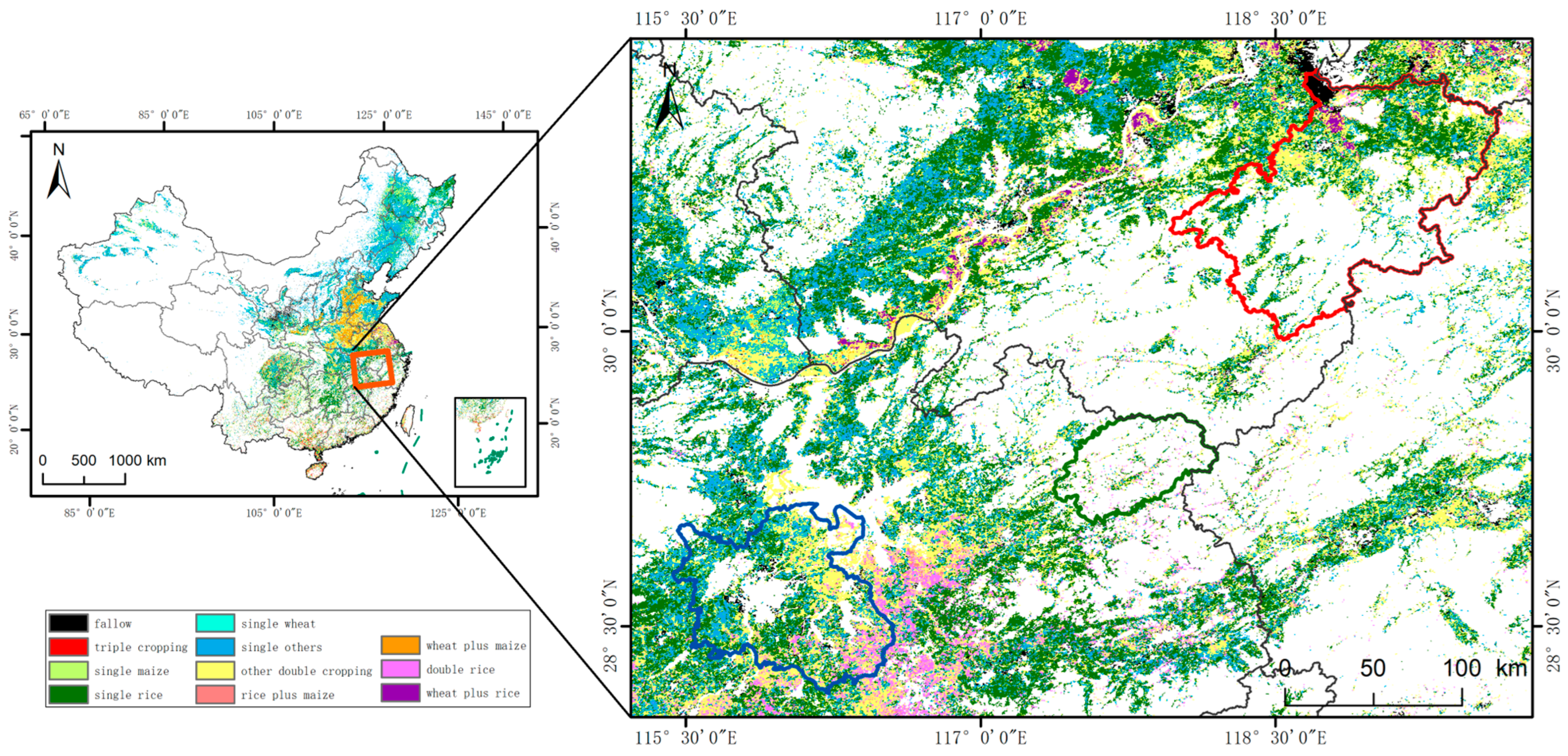
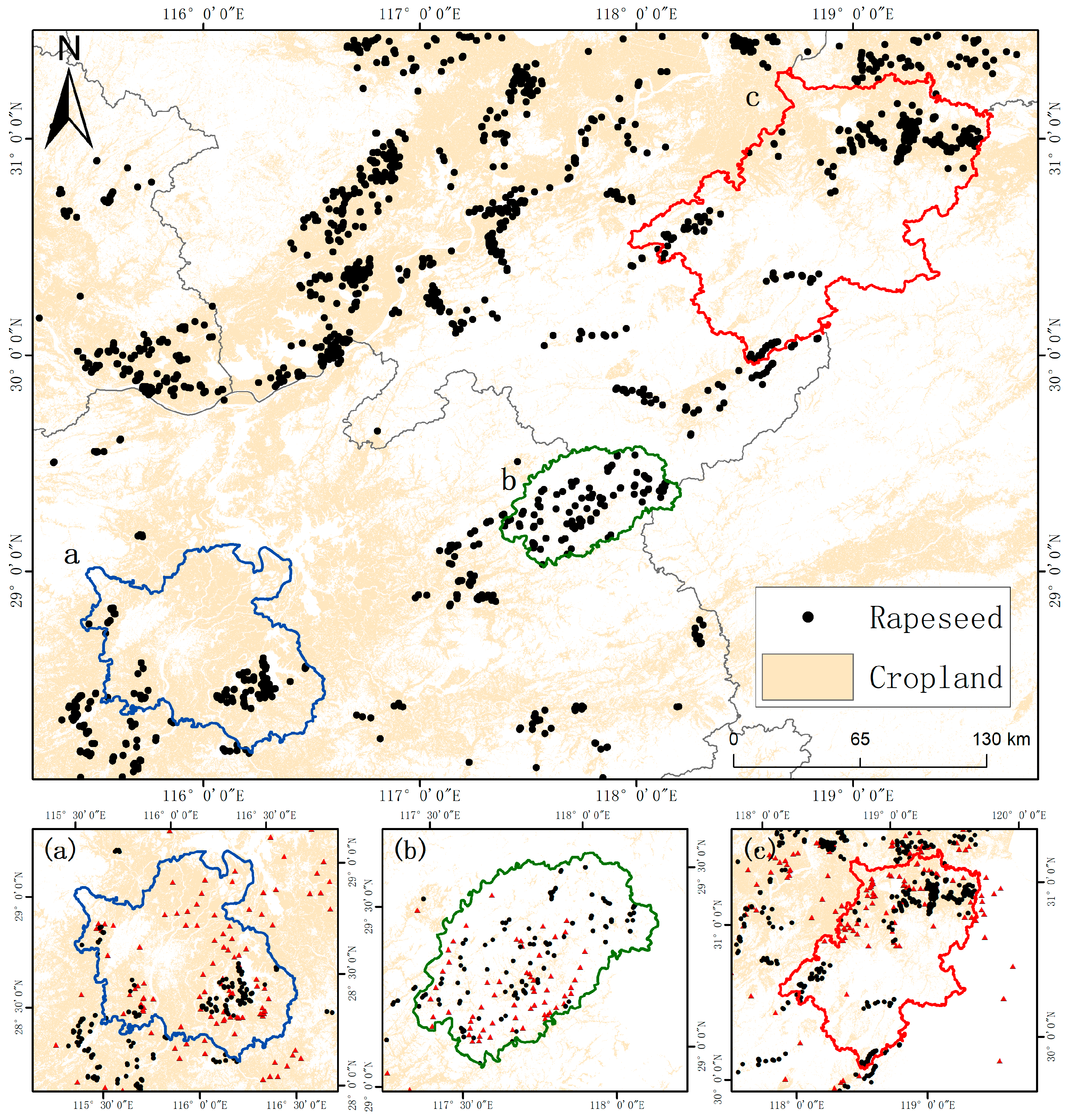
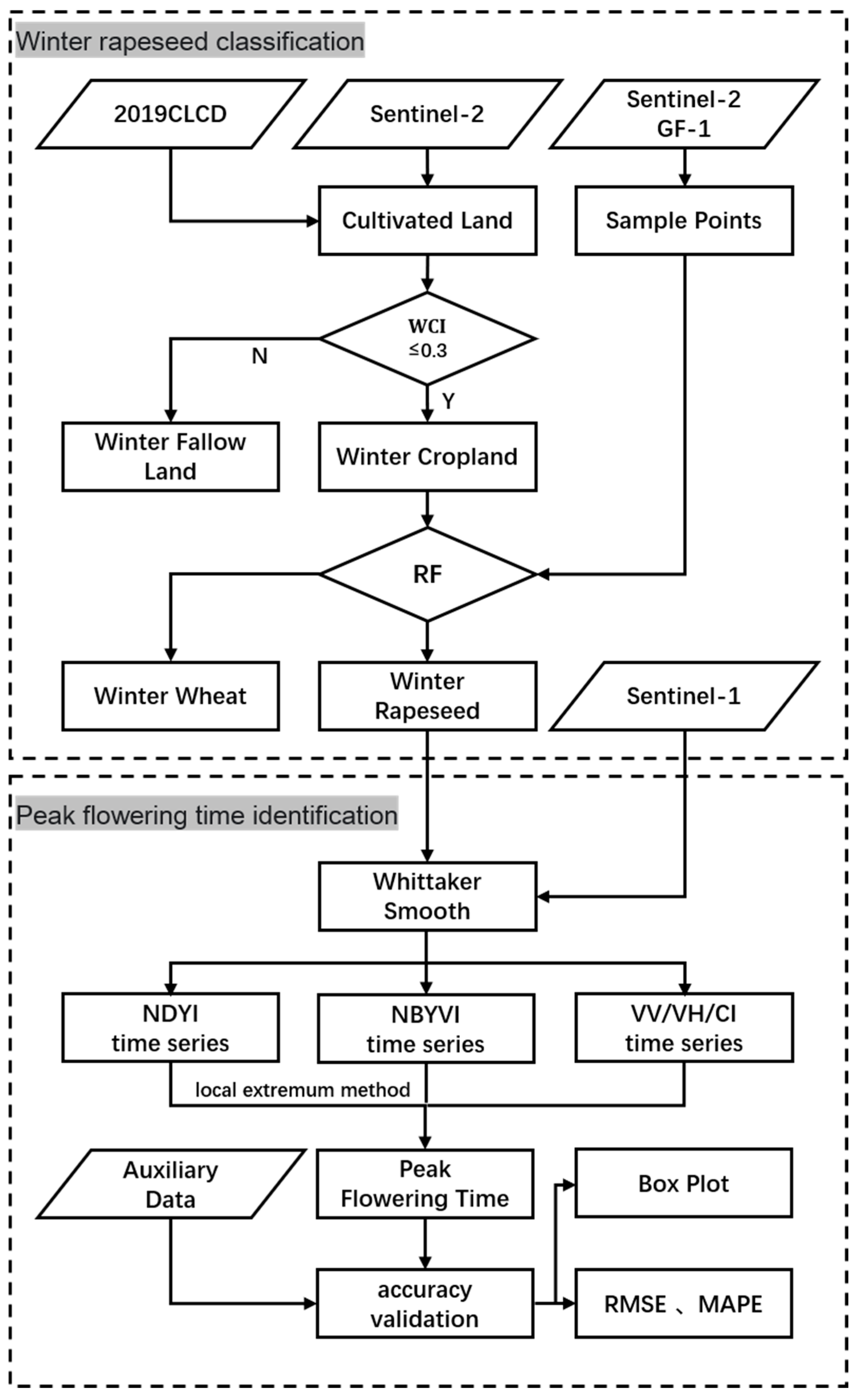
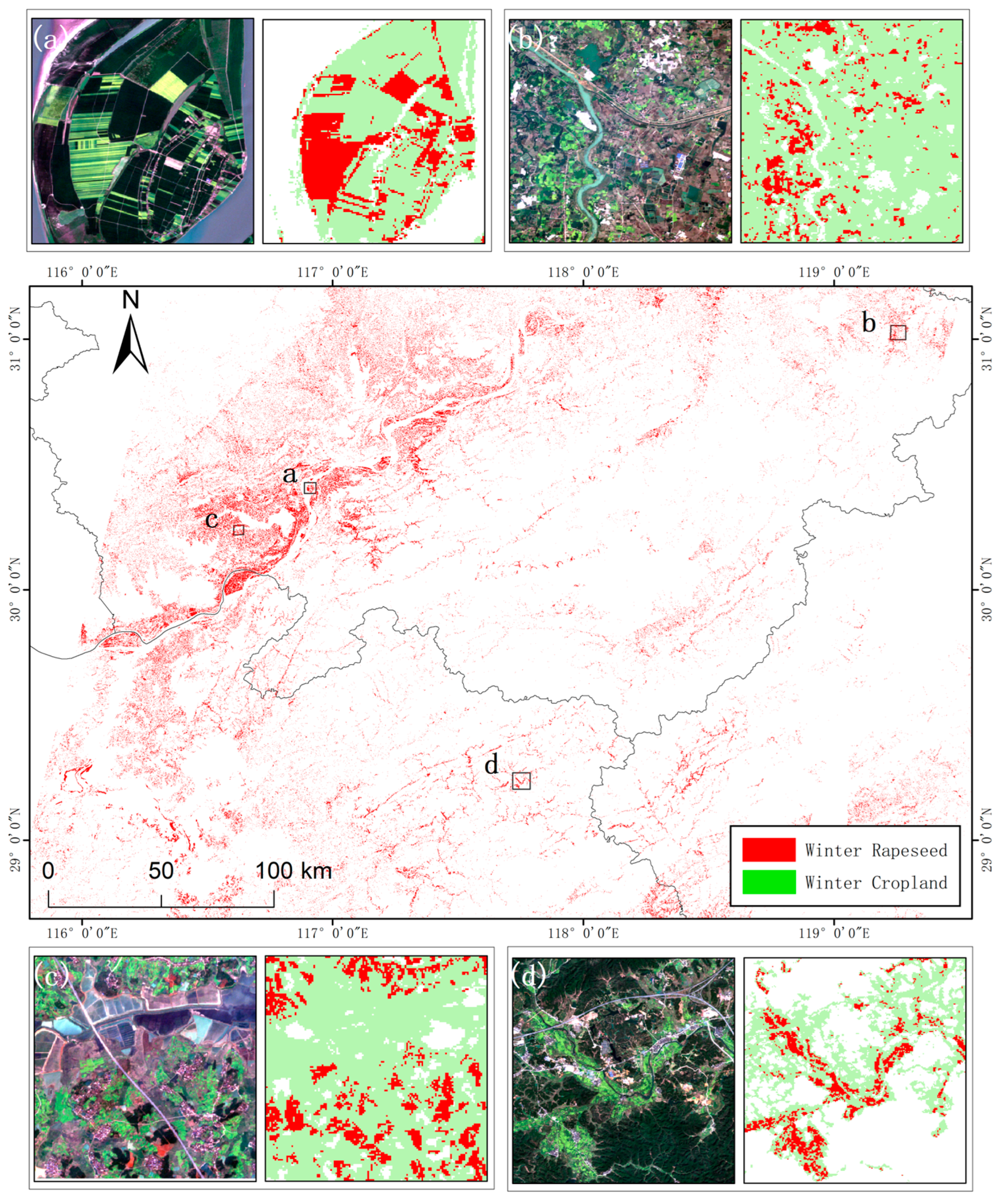
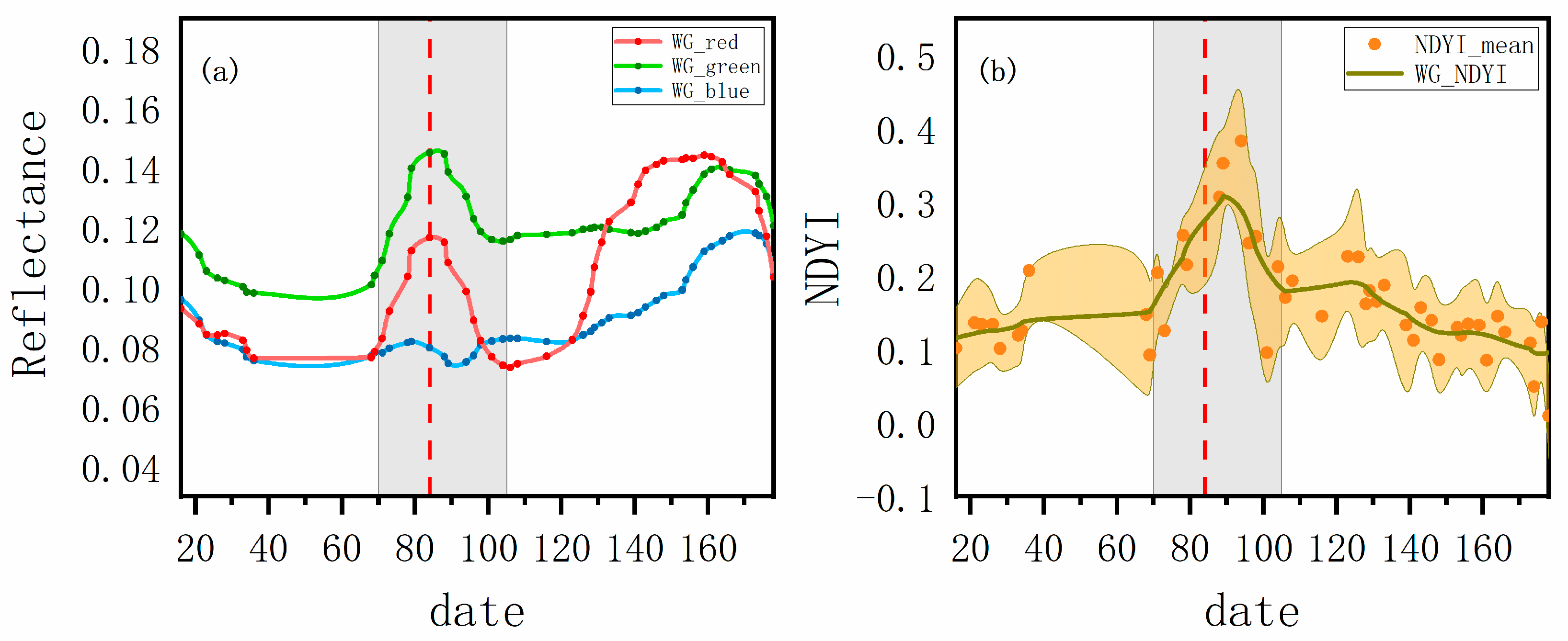
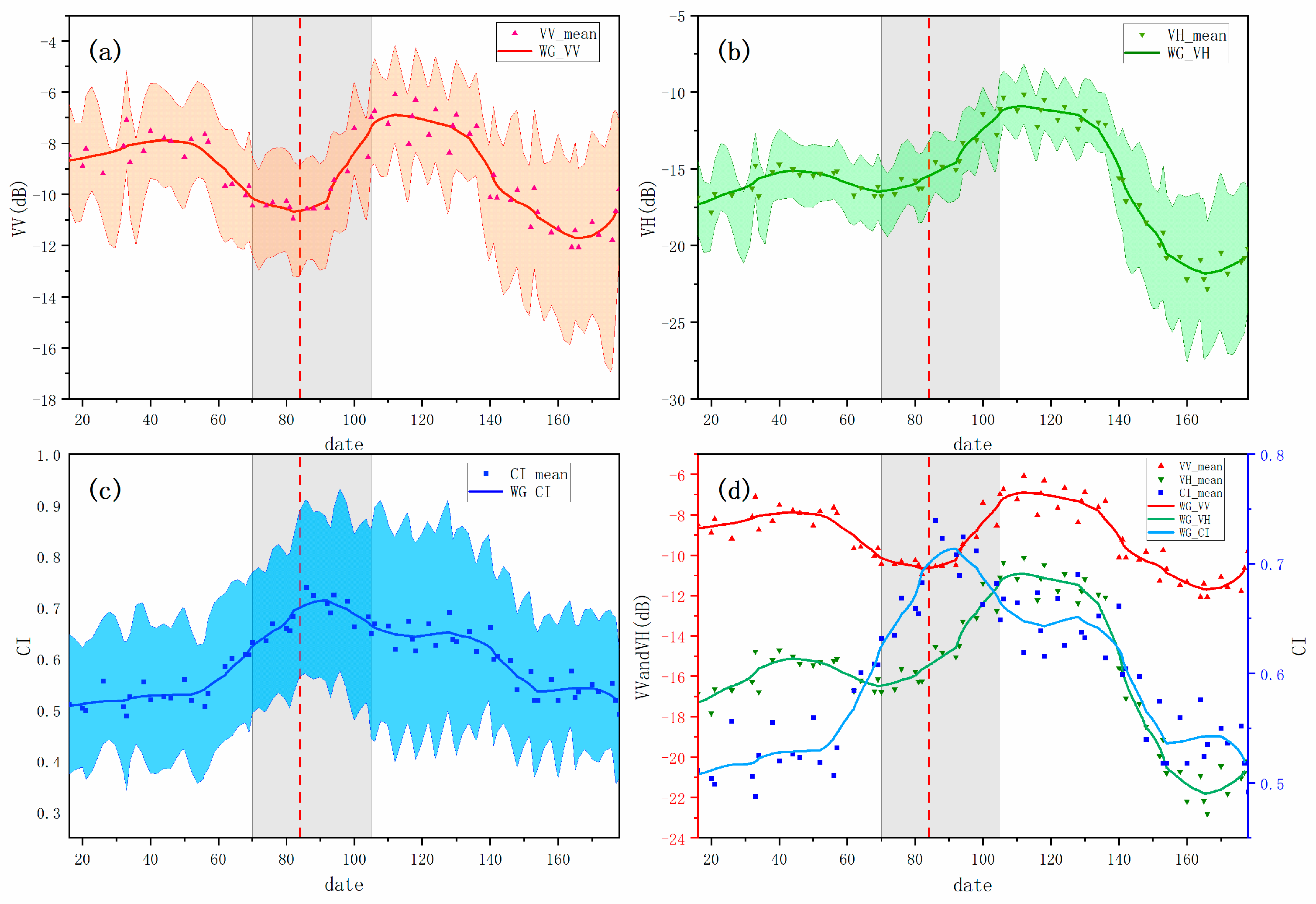
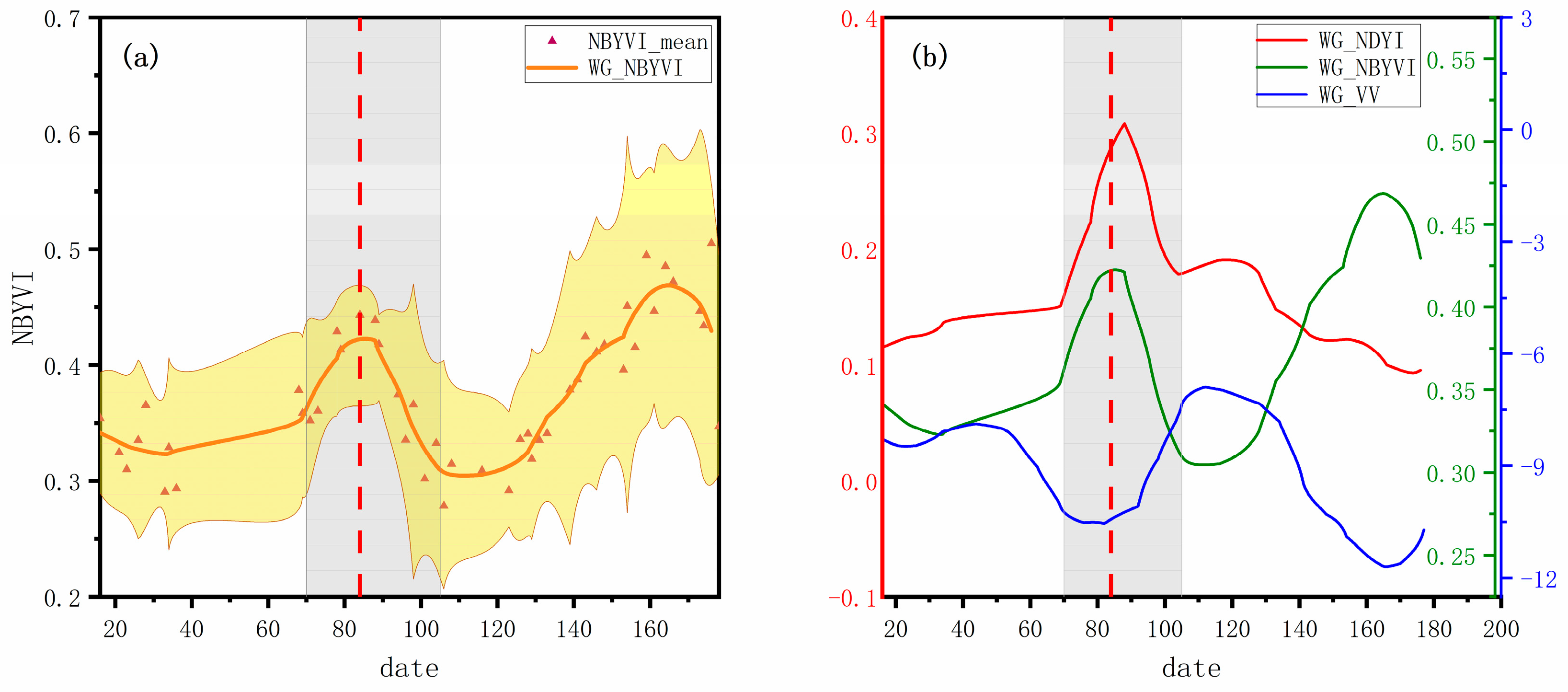



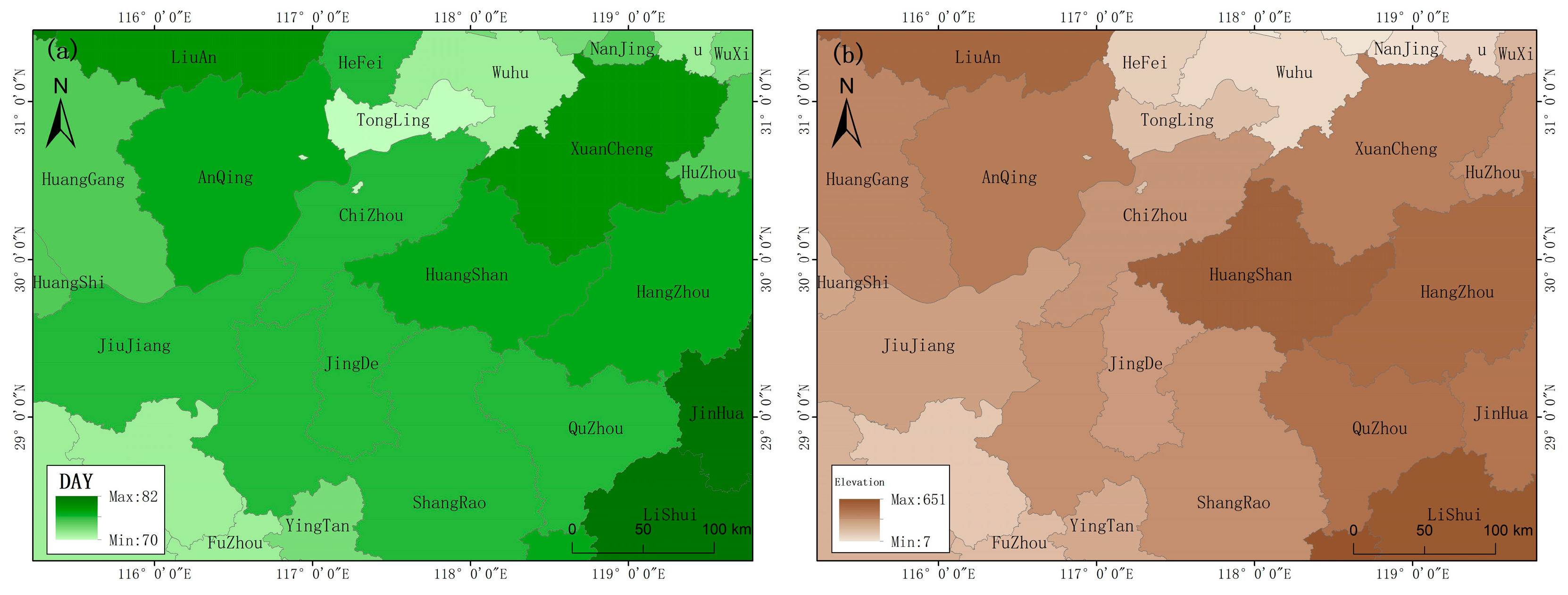
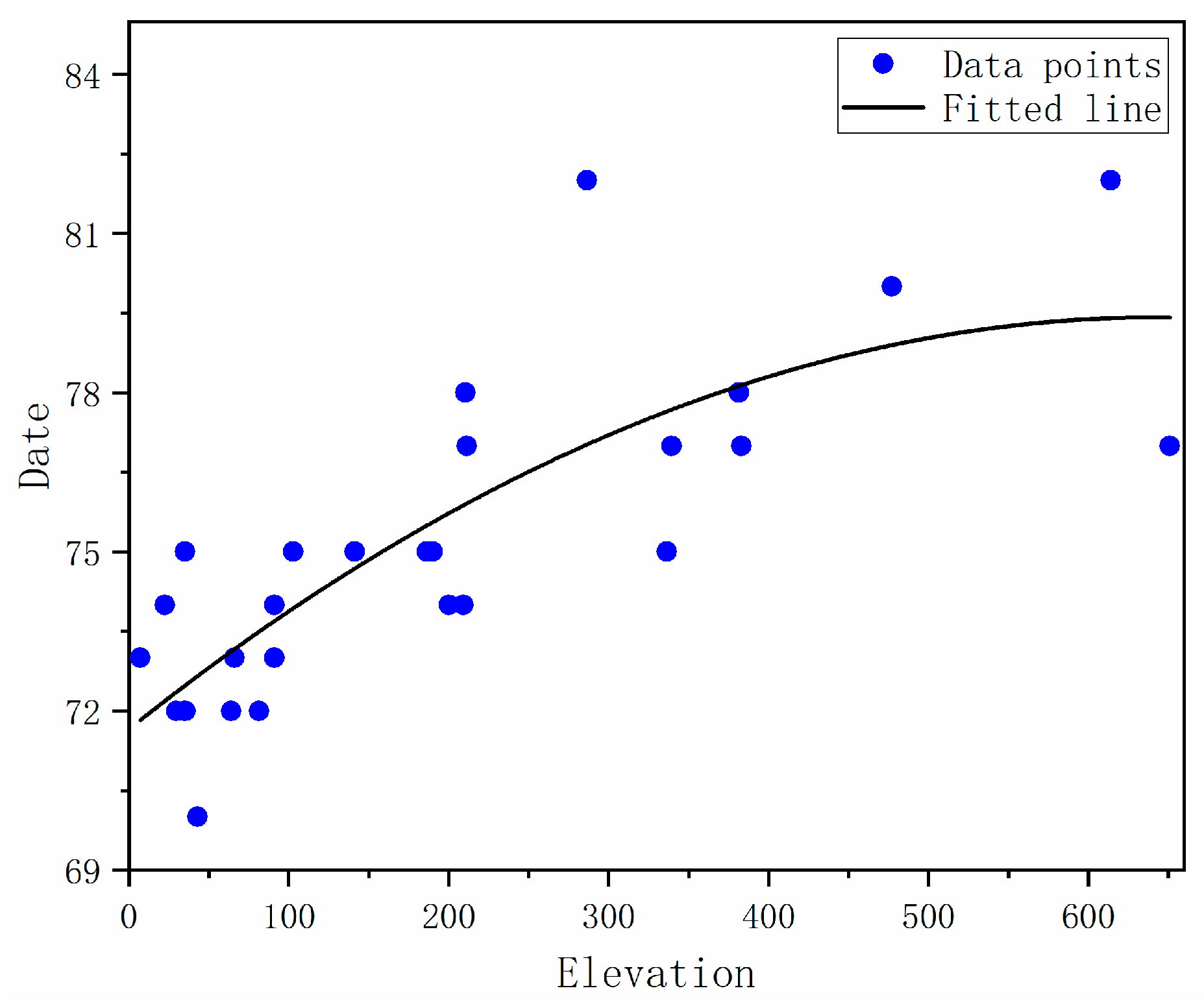

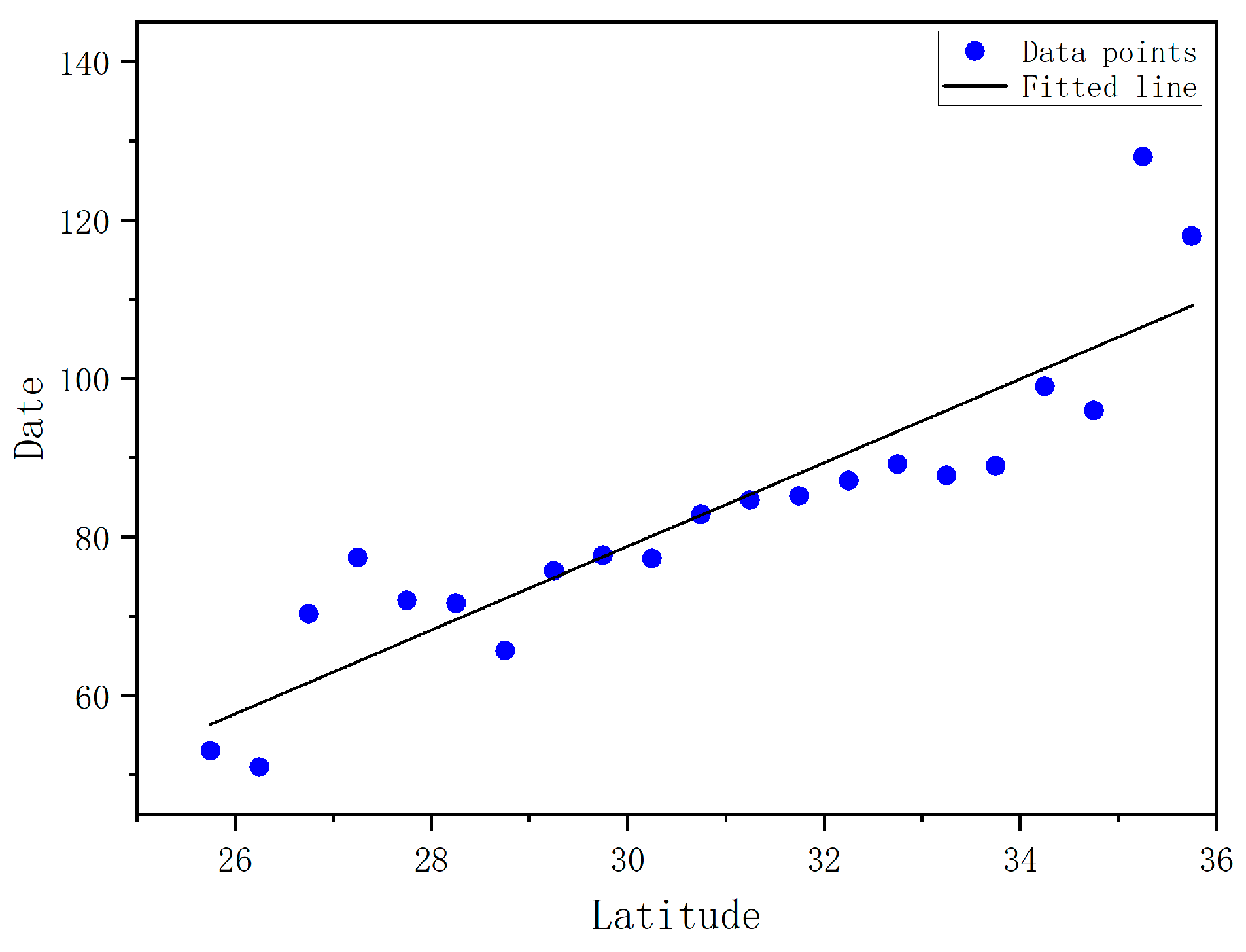
| Auxiliary Data Types | Data Content | Data Source |
|---|---|---|
| Land Cover Classification Data | 30 m Annual Land Cover Classification Data (CLCD) for China in 2019 | https://zenodo.org/records/4417810 (accessed on 15 May 2024) |
| Crop Planting Pattern Type | Maps of Cropping Patterns in China for 2015–2021 | https://figshare.com/articles/dataset/Maps_of_cropping_patterns_in_China_during_2015-2020/14936052 (accessed on 26 May 2024) |
| Temperature data | National Climatic Data Center | https://www.ncei.noaa.gov/data/global-summary-of-the-day/archive/? C = M; O = A (accessed on 26 May 2024) |
| Crop Phenological Data | 2019 Xuancheng City Winter Rapeseed Peak Flowering Dates | the Xuan Cheng Municipal People’s Government (https://www.xuancheng.gov.cn/ (accessed on 3 July 2024)) |
| 2019 Wuyuan County Winter Rapeseed Peak Flowering Dates | the Wuyuan County People’s Government (http://www.jxwy.gov.cn/ (accessed on 3 July 2024)) | |
| 2019 Nanchang City Winter Rapeseed Peak Flowering Dates | the Nan Chang Municipal People’s Government (https://www.nc.gov.cn/ (accessed on 3 July 2024)) |
| Verification Area | RMSE | MAPE | ||||
|---|---|---|---|---|---|---|
| NDYI | NBYVI | VV | NDYI | NBYVI | VV | |
| Nanchang | 13.6672 | 6.2367 | 7.8036 | 0.1341 | 0.0670 | 0.0876 |
| Xuancheng | 20.1758 | 6.2155 | 6.3046 | 0.2153 | 0.0342 | 0.0666 |
| Wuyuan | 12.4475 | 6.5016 | 25.5634 | 0.0998 | 0.0751 | 0.2807 |
Disclaimer/Publisher’s Note: The statements, opinions and data contained in all publications are solely those of the individual author(s) and contributor(s) and not of MDPI and/or the editor(s). MDPI and/or the editor(s) disclaim responsibility for any injury to people or property resulting from any ideas, methods, instructions or products referred to in the content. |
© 2025 by the authors. Licensee MDPI, Basel, Switzerland. This article is an open access article distributed under the terms and conditions of the Creative Commons Attribution (CC BY) license (https://creativecommons.org/licenses/by/4.0/).
Share and Cite
Wu, F.; Lu, P.; Chen, S.; Xu, Y.; Wang, Z.; Dai, R.; Zhang, S. Identifying the Peak Flowering Dates of Winter Rapeseed with a NBYVI Index Using Sentinel-1/2. Remote Sens. 2025, 17, 1051. https://doi.org/10.3390/rs17061051
Wu F, Lu P, Chen S, Xu Y, Wang Z, Dai R, Zhang S. Identifying the Peak Flowering Dates of Winter Rapeseed with a NBYVI Index Using Sentinel-1/2. Remote Sensing. 2025; 17(6):1051. https://doi.org/10.3390/rs17061051
Chicago/Turabian StyleWu, Fazhe, Peng Lu, Shengbo Chen, Yucheng Xu, Zibo Wang, Rui Dai, and Shuya Zhang. 2025. "Identifying the Peak Flowering Dates of Winter Rapeseed with a NBYVI Index Using Sentinel-1/2" Remote Sensing 17, no. 6: 1051. https://doi.org/10.3390/rs17061051
APA StyleWu, F., Lu, P., Chen, S., Xu, Y., Wang, Z., Dai, R., & Zhang, S. (2025). Identifying the Peak Flowering Dates of Winter Rapeseed with a NBYVI Index Using Sentinel-1/2. Remote Sensing, 17(6), 1051. https://doi.org/10.3390/rs17061051







